Note
How many political parties were there during the revolution?
Because duo to the popularity (I mean by popularity "the most influential" like "Jacobin" and "Girondins" etc. ) I start to forgot that was there more political parties so could you tell us about them and their most notable achievements ?
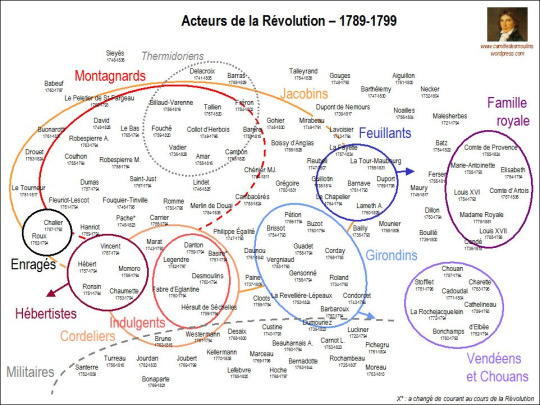
It is hard to really talk about political parties when it comes to the French Revolution, at least not in the way in which we today think of the term, with worked out ideologies and party programs for each and everyone. Furthermore, some of these ”parties” are not like the others. Jacobin, Cordelier and Feuillant all refer to people belonging to a certain political club, paying money for their membership, whereas girondins, montagnards, thermidorians, enragés, hébertists (and robespirreists that are not mentioned in the chart) all are loose compounds of people that pushed for (or were at least said to push for) the same political changes, and often were personal friends as well. The vagueness of all of this has lead to debates not only regarding what each group really stood for, but even who really belonged to them. My understanding of these groups is honestly not much deeper than what can be read on wikipedia (each group already has its own page) but to shortly summarize:
Jacobins — members of the Jacobin Club (Society of the Friends of the Constitution) which was founded in 1789 and shut down in November of 1794. It’s main quarter was on rue Saint-Honoré in Paris, but unlike the Cordeliers and Feuillants, it also set up sister clubs out in the provinces. This makes the Jacobins the biggest political group throughout the revolution in terms of official members. When it comes to ideology, the club’s first set of official reglutions, passed on February 8 1790, stated that ”the object of the Society of Friends of the Constitution is: 1, to discuss in advance the questions which must be decided in the National Assembly; 2, to work towards the re-establishment and strengthening of the constitution according to the spirit of the preamble above; 3, to correspond with other Societies of the same type which may be formed in the kingdom” as well as that ”loyalty to the constitution, dedication to defending it, respect and submission to the powers it has established, will be the first laws imposed on those who wish to be admitted to these Societies.” However, as the revolution radicalized, so did the Jacobin club.
Cordeliers — members of the Cordelier Club (also known as the Society of the Friends of the Rights of Man and of the Citizen) which existed from 1790 to 1795. Its head quarter was in the Cordeliers Convent (hence the name) in Paris, located on 15 rue de l'École de Médecine. The Cordeliers had lower fees in comparison to the Jacobins, and as a result, counted more working class men and women among its members. Its leaders were however still middle class. The Cordeliers are traditionally described as more radical than the Jacobins.
Feuillant — member of the Feuillants Club (Society of the Friends of the Constitution), founded on July 16 1791. The group held meetings in a former monastery of the Feuillant monks on Rue Saint-Honoré in Paris, hence the name. The club was for upholding the Constitution of 1791, which designated France as a constitutional monarchy.
Girondins (also sometimes known as Brissotins or Rolandins) — political group which existed within the Legislative Assembly and then National Convention, in particular the 29 deputies ordered arrested by said Convention on June 2 1793. Of these, 20 would be guillotined in Paris on October 31 the same year, while many others fled to be executed or commit suicide in order to prevent it across the following months. The name ”girondin” stem from the fact many of the groups alleged members originated from the department of Gironde. In the article The "Girondins" Were Girondins, after All (1988) Frederick A. de Luna concludes that the earliest labeling of girondins as girondins stem from April 1792, after which they grew to be frequently used by their enemies. The girondins themselves did however never use the name, and in the pamphlet J. P. Brissot, député à la Convention nationale, à tous les républicains de France ; sur la société des Jacobins de Paris (October 1792) Brissot even exclaimed ”Will the slanderers now remain silent? Will they stop pretending to believe and wanting to make believe in a faction of Gironde or of Brissot?” The girondins have traditionally been associated with 1, waging a pro-war campaign within the Legislative Assembly and the Jacobin club from December 1791 to April 1792 (as can be seen above, the first recorded labeling of girondins as girondins is from the same month said war was declared), pushing for a more liberal economy as well as seeking more ”moderate/less violent” solutions compared to the Mountain during the time of the Convention. However, there’s no actual safe connections between these goals and all the men tradionally described as girondins for as far as I’m aware. To give the word to Terror: the French Revolution and its Demons (2022) by Michel Biard and Marisa Linton:
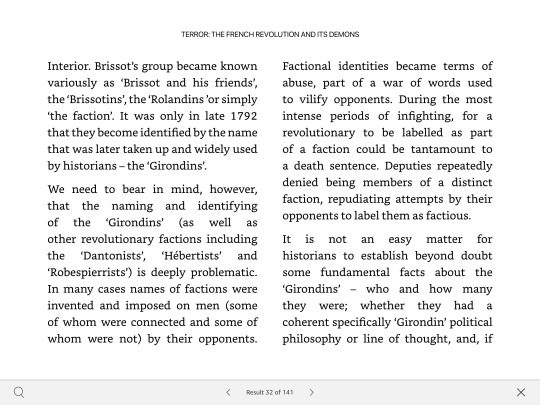
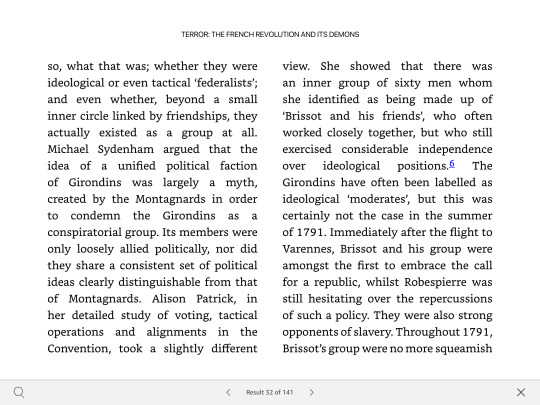
Montagnards — member of the Mountain, a group within the Legislative Assembly and then especially the National Convention, so dubbed because its members occupied the highest benches of the hall of the assembly. I honestly don’t really know what defines this ”party” more than being opponents of the girondins. So while the latter are associated with being pro-war, for a more liberal economy and reluctant to ”violent/exceptional measures”, the Montagnards are instead described as anti-war, for a more planned economy and welcoming of more ”violent/exceptional measures.” However, like in the case with the girondins, were we to line up every person tradionally described as a montagnard and check up his stance on each of these three topics, I’m unsure if we would actually get a very unified result.
Unlike in the case of the girondins, indulgents and exagères, we have proof of the montagnards describing themselves as just that. Here is Robespierre, who might as well be called the leader/heart of the ”party,” defining what a montagnard is on June 12 1794. More than anything, it may however rather illustrate how this wasn’t a properly defined group either, as I’m sure the members of every other ”party” discussed here would be willing to describe themselves in the exact same way:
Yes, Montagnards, you will always be the boulevard of public liberty; but you have nothing in common with intriguers and perverts, whoever they may be. If they try to deceive you, if they claim to identify with you, they are no less foreign to your principles. The Mountain is nothing other than the heights of patriotism; a Montagnard is nothing other than a pure, reasonable and sublime patriot.
The fall of Robespierre marks the beginning of the end for the Mountain, many of who’s members would be expulsed, executed and exiled during the thermidorian convention.
Thermidorians — the name has its origin in the journée of 9 thermidor (July 27 1794), the day Robespierre and his allies fell from power, but it is not fully clear if it is active participation in/support of said journée, or holding power during the period that followed it, which is distinguished by its step back, for better or worse, from the more ”revolutionary measures” taken during 1793-1794 that makes someone a thermidorian. In the article ”Robbers, Muddlers, Bastards, and Bankrupts?” A Collective Look at the Thermidorians (2019) Mette Harder writes that this too is a very poorly defined group — ”Beyond their individual names, there is, however, no clear sense of who the Thermidorians were collectively, how cohesive a group they became, and what exactly they hoped to achieve while in power. Their name itself adds to this uncertainty, as it is used interchangeably to describe a specific group of reactionaries and the entire Convention post-thermidor.”
Indulgents (also sometimes known as dantonists) — group associated around Convention deputy Georges-Jacques Danton, and in particular those executed alongside him on April 5 1794. Traditionally described as driving a campaign that was about softening ”the terror” as well as pushing back from dechristianization from late 1793 up until their execution. This idea is however something that has been heavily contested in more recent years, some historians concluding the Indulgents never were a coherent group with a common goal to begin with but that this was rather something contructed by their enemies in time for their trial (see for example chapter 8 — Le chef d’un groupe indulgent ? — of Danton: le mythe et l’histoire (2016) or Camille et Lucile Desmoulins: un rêve de république (2018).
Hébertists (also known as exagères) — group associated around the journalist Jacques René Hébert, and in particular those that were executed alongside him on March 24 1794. Drove a campaign for a hardening of ”the terror” and dechristianization from late 1793 up until the execution. Like with the indulgents, it’s however hard for me to say if the members themselves identified themselves as a group or if this is a post-construction.
Enragés — just read this. I honestly had trouble finding much more.
94 notes
·
View notes
Text
Marat's critique on scientific academies
"Even though the following letter does not come from the same quill, I felt obliged to include it here anyway, because it reveals some piquant facts that are perfect to show the uselessness of scientific societies and to reveal the shameless charlatanism of their members."
Letter XII
"It is not true, Monsieur, that the academies have never made some discoveries, although their members have often stolen those of others. On the subject, I could mention one hundred traits of infidelity of Messrs. the academicians of Paris; one hundred cases of misuse of funds; one hundred inventions publicly claimed by their authors, and what is even stranger, one hundred mémoirs that have been made to disappear and then carelessly published again under the names of these shameful plagiarists, but I do not want to demoralise you. Thus, I will limit myself to clear your doubts with two anecdotes that you will find amusing and of which you can find proof easily, since they happened before our very eyes.
You remember the enthusiasm about the rise of the first aerostatic globe and the craze of the public for this kind of exhibition. You remember the wonderful discoveries, of which this new experience was the source; you also remember the multiple as well as vain attempts done to steer the balloons. Well? Some fools, who believe that genius resides in the Academy of Science, gave it twelve thousand livres to figure out a way to control [the balloons]. What happened to that money? Do you think it reached its destination? Do not fool yourself. Do you think it was used for some useful research? How naive you are. Just know that our savants shared it among themselves and that it was all squandered at the Rapée, at the Opera and with women. You blush for them, but this is just a small thing, listen to this other bolder courtesy of theirs.
Some months ago, a deputy, prompted by the work of an author, proposed in the National Assembly to proclaim the equality of weights and measures through all the reign. The proposal was well received and sent to the Academy of Science in order to decide how to proceed. It only took them the time to puff themselves up, to put their scribes to work and to rush to the senate that Messrs. the scientists were ready to announce that the Academy had found the best method to fulfil the expectations of the Assembly. It was to derive all the measures from the one of the circumference of the terrestrial globe; a method that some venal quills have immediately presented as a superb discovery by our doctors. But where do you think that this sublime method comes from? From the Egyptians. It was to pass it on to future centuries that the famous pyramids were built, which many clueless travellers took for eternal monuments of the greatness of these people. Eh! And where do you think that our academicians took this magnificent system from? They took it word for word from the treatise on weights and measures of the Ancients, published by Romé de l’Îsle, a distinguished savant, whose name they have taken care to overshadow since his death, in order to steal from him, after having persecuted him his whole life. But the best is yet to come. Under the pretext to measure a degree of the meridian arc - already well determined by the ancients and of which it would be impossible today to alter the measure without overthrowing this admirable system - they have been granted by the minister one hundred thousand écus for the expenses of the operation; a gâteau that they will share among their associates.
Judge for yourself the usefulness of the academies and the virtue of their members. The academies of the capital, which have never done anything for the progress of human knowledge other than persecute true men of genius; those will be preserved by conscript fathers, for the fact that the nation is in charge of [the academies] and that they consist of vile supporters of the despot, pavid advocates of despotism."
—from Jean-Paul Marat's "Les charlatans modernes ou lettres sur le charlatanisme académique", letter n° 12, p. 40
Highlights in italics are mine. I thank @pleasecallmealsip for helping me with a couple of words I didn't know how to translate.
13 notes
·
View notes
Text
Obviously this can be done well + there is nuance but the way that many works of historical fiction would rather cast an actor of colour in the role of someone who was historically extremely racist over doing any research to tell the stories of actual real life poc who existed at the time rlly irritates me. like u people know that there were real black people during the regency right. you know that you don't have to diversify the racist colonialist early nineteenth british upper classes in the weirdest way possible to have black people during the regency because there were in fact actual black people there in real life right
249 notes
·
View notes
Text
happy birthday to the world's most special boy
3 notes
·
View notes
Text

made this based on a illustration i saw ♡
106 notes
·
View notes
Photo

Since the publication of Carnot’s Mémoires, it is classic to divide the Committee of Public Safety into several categories and various political tendencies, [and], notably, to oppose « généralistes » and « spécialistes ». The former would determine the political orientations of the government, whereas the latter would withdraw into their area of expertise. [In his Dictionnaire des membres du Comité de Salut Public,] Bernard Gainot recently reminded us that this division must not be overstated, and that the assignment of a member of the Committee to a particular role often had only a very formal side. […]
The members of the Comittee deliberated most matters in common, as and when they came up, without having a precise agenda. Prieur de la Côte-d’Or evokes a work that began around seven o’clock in the morning for the early risers, in order to continue until late afternoon, interrupted for some members by the sessions of the Convention or the meetings of the Jacobins. After a brief meal, the present members came together again around eight o’clock in the evening for a meeting that went on deep into the night, sometimes until one or two o’clock in the morning, which barely left more than five or six hours of rest for the most hardworking members. Carnot, for his part, estimates the number of matters treated on a single day at several hundred, adding, almost as a corollary, « nights without sleep, indescribable fatigues, endured in order to pull the State out of its terrible crises […] ».
Collot estimates his average workday at the Committee at fifteen hours, [and] also mentions the « long works which often consumed entire nights », an activity which:
… offered such a continuity of details, that I saw myself deprived for eight months of eating at my home. Hastily, I ate a frugal meal everyday in the vicinity of the Committee. Carnot was forced to act likewise, as was Prieur (de la Côte-d’Or). They know about my assiduousness; only theirs and the one of Lindet could surpass it.
All members of the Committee bore testimony to this, signatures en second gave each other confidence and the responsibility was collective. Consequently, the areas that were reserved to one member or another could prove to be very theoretical.
Collot d'Herbois: légendes noires et révolution (Michel Biard), p. 116f.
52 notes
·
View notes
Note
as a frenchman i was confused and surprised at how much you guys as a whole dislike napoleon? he gets a lot of deserved rep for saving the country imo
bro he led 400,000+ French people to their deaths
meanwhile people act like the ~35k killed by the Reign of Terror was the worst humanitarian catastrophe in the history of humanity. it's just the double standard that pisses me off.
#my grandma is a Napoleonist and that's half the reason why I got into 'this part' of frev in the first place#I love her but we cannot talk about history#also prev you are absolutely right
60 notes
·
View notes
Text
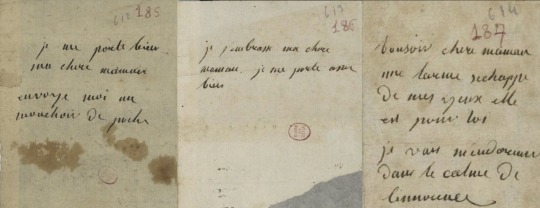
I’m doing fine my dear maman. Send me a pocket handkerchief.
I embrace you my dear maman. I’m doing pretty well.
Good evening dear maman. A tear falls from my eyes. It is for you. I’m going to fall asleep in the tranquility of innocence.
Three notes written by Lucile Desmoulins to her mother between her arrest on April 4 1794 and execution nine days later. The last one is generally seen as a final farewell, penned down right after the death sentence had been pronounced on April 13.
106 notes
·
View notes
Text
Goujon's beautiful head, — fine, feminine, beardless, a straight aquiline nose, above a small and serious mouth, a strong chin, and, framing this calm face of such a charming resolve, long hair, that we divine silky, much like the hair of an Erminia escaping from her helmet, — rises above this group. This firm and soft Spartan walks to the front row. Over the benches of the Assembly stood his six-feet* tall figure.
Jules Claretie, Les derniers Montagnards: histoire de l'insurrection de prairial an III (1795), 1867
*probably pied-du-roi, which means Goujon's height was approx. 195cm/6.4ft
39 notes
·
View notes
Text
Having joined the prosecutor’s office to learn procedure without pay, [Tissot] wasn’t as bound by assiduity as his friend [Goujon] and he sometimes took vacations that he would spend in [his hometown of] Versailles. Goujon then felt more than ever the “boredom of scribbling” that he had no means to escape. But when Tissot came back to him, he was soon filled with courage again.
Le conventionnel Goujon (1766-1793), L. Thénard, R. Guyot, 1908

21 notes
·
View notes
Text
Goujon's teenage years among slavers in Saint-Domingue
A wealthy relative, planter in Saint-Domingue, had requested the child to be sent to him, offering to subsequently associate him to his business. Claude Goujon (tn: Goujon's father) agreed, not without apprehension. His son was so young and frail (tn: Goujon was eleven or twelve), and the passage to Saint-Domingue took forty days on average, without accounting for headwinds, storms or dead calms.
He entrusted him to a friend in the Royal Navy, whose ship was departing for the Antilles. This added the danger of getting caught between fires. Jean-Marie saw the British fleet up close, and maybe even witnessed the battle of Ouessant. He must have arrived in Saint-Domingue during the Autumn of 1778.
Saint-Domingue was the realm of "black cattle", the longtime standard for suffering and slavery. He stayed there for eight years, all his adolescence; later in life, he would seldom talk about those years, and only then with a few bitter words: "I have rarely seen," he said, "anyone who was true, who had any morals, and within whom the voice of humanity could be heard." To him, Michelet says, this vision was like "the charcoal fire mentioned in the Bible", a dreadful sight that would haunt him; he remained grieved by it all his life, precociously grave in all things, even in his joys.
Le conventionnel Goujon (1766-1793), L. Thénard, R. Guyot, 1908
19 notes
·
View notes
Text
Goujon and Tissot make their cottagecore fantasy come true
Money was lacking; for one year, Goujon saved up on his clerk wages; Tissot received financial help from his family. On the first days of Spring 1790, they strolled around the Parisian suburbia looking for a suitable lodging to retreat to; in early May, they left the prosecutor's office and moved away from Paris.
They didn't venture too far to find their "Thebaid". They rented to the Countess of Coubron a small house in Meudon, on a hillside by the Seine riverbank, near to the entrance to the woods. From there, in just two hours, Tissot could walk to Versailles and Goujon could visit Mongez, who was taking care of his mail and of questions from prying folks. Jean-Marie hadn't given his new address to anyone; he couldn't even bring himself to announce his leave to his terrible Aunt Cottin. He only informed his mother at the end of May, without saying yet where he had gone to. Mrs Goujon received the news with surprise and without pleasure; she assumed that some suspicious adventure was going on, and that the "intimate friend" Jean-Marie was telling her about for the first time could well actually be a female friend; she judged her son based on young people of the same age, a mistake only someone who didn't know him too well would make. He protested vehemently and begged his mother to calm down and trust him.
Le conventionnel Goujon (1766-1793), L. Thénard, R. Guyot, 1908
21 notes
·
View notes
Text

Les Derniers Moments de Michel Lepeletier
(engraving by Tardieu after David's painting, now lost)
50 notes
·
View notes
Text
I wasn't pleased with the last drawing I did and felt to urge to do an emergency one >.<

...did I make him too cool? :( To my defense, let's say it's Carnot seen by Prieur...
36 notes
·
View notes
Text




A little comic based on »Robespierre« by Romain Rolland, Act 3 Scene 6.
273 notes
·
View notes
Text
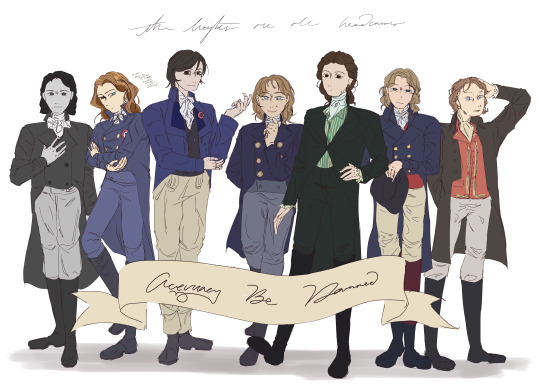
a colorful cast of characters (real)
102 notes
·
View notes

